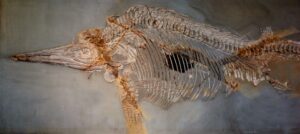By atlasobscura.com.
A marine reptile fossil from Svalbard challenges ideas about evolution and Earth’s greatest mass extinction.
Australian-born Benjamin Kear is a hunter of the High Arctic. With colleague and friend Jørn Hurum, he chose a quarry, and set off across the treeless expanse of Norway’s Spitsbergen, part of the Svalbard archipelago, where wind and snow roar across the landscape, even at the height of summer. There, the steep sides of barren mountains crumble and slump from erosion, exacerbated by the freeze-thaw cycles of melting permafrost. Soft, almost mud-like pieces of shale slide down their flanks, revealing hints of the creature they pursued.

“It’s the hardest field work I’ve ever done,” Kear says, safely back in his Uppsala University office. “You’ve got your rifle on your shoulder and there’s polar bears running around. On our last trip we were stuck in the tents for 36 hours in a blizzard.”
Team members carried the rifles because the archipelago’s polar bears outnumber humans—but they relied on other tools for their hunt. “This is what we’re using,” Kear says, holding up a worn, faded green notebook about the size of a smartphone. “It’s actually the 1929 diary, and I’m hunting through the field notes. The idea is to go back and trace what they were doing when they were finding bits.”
The bits in question are fossils and, for more than a century, other hunters have come to what’s known as the Vikinghøgda Formation in search of bones. The earlier expeditions had mapped their discoveries, and the kinds of rock they were found in, creating a record that Kear and his fellow paleontologists have relied on in their search for the first member of one of Earth’s most successful animal groups. And they found it. Sort of.

